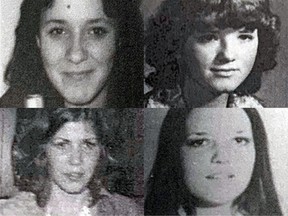While it must be a relief for the surviving relatives of four Calgary females brutally murdered by a serial sex offender nearly a half-century ago, it must also be a source of dismay that Gary Srery took his final breath believing he had gotten away with their killings

Article content
Technological advances in the world of forensic criminal investigations means that no offender, no matter how long they have escaped justice, is safe from prosecution.
Advertisement 2
Article content
But while today’s investigative methods can solve long-forgotten heinous crimes, they can’t guarantee one thing most victims and their families may wish for more than anything else — bringing offenders to justice.
Article content
While it must be a relief for the surviving relatives of four Calgary females brutally murdered by a serial sex offender nearly a half-century ago, it must also be a source of dismay that Gary Srery took his final breath believing he had gotten away with their killings.
Srery died on April 27, 2011, having never been identified as the murderer of Calgary teens Eva Dvorak and Patricia McQueen and young women Melissa Ann Rehorek and Barbara MacLean.
It took the hard work and diligence of dedicated Alberta RCMP members and Calgary police officers using the latest technology, a method known as Investigative Genetic Genealogy, to finally pin their murders on Srery.
Article content
Advertisement 3
Article content

That Srery died in an Idaho prison serving a life sentence for rape (the same sentence he would have received for killing his four Calgary victims) must give some solace to the family members who for decades were left with nothing but questions.
Through the Mounties, relatives of each of the victims released statements following the announcement last week revealing Srery as a serial killer.
In them, you can find hints at the fact the news didn’t provide complete closure, although all were appreciative of the efforts of law enforcement in solving the cases.
“Today marks a significant moment in the long journey of seeking justice for our daughter, sister, aunt, cousin and niece,” wrote MacLean’s family. “It is our hope that we all may find a measure of peace in the days ahead.”
Advertisement 4
Article content
Added the family of 14-year-old McQueen, who was found along with her good friend Dvorak, just outside the then-city limits in February 1976: “This evil monster has caused so much pain and suffering for countless families … We thank God that he is no longer alive and can never harm anyone else.”
Despite Srery’s passing, however, his name should not be quickly forgotten.
Recommended from Editorial
-

10/3 podcast: How Alberta RCMP linked four murders to a suspected serial killer
-

Sisters of serial killer victim Eva Dvorak horrified but relieved to fully learn what happened
-

Police look for more answers in wake of serial-killer shocker
-

What we know so far about the serial killer’s victims: ‘If the person could only know of the grief he has caused’
-

More victims sought as RCMP say serial killer linked to four Calgary slayings in 1970s
Advertisement 5
Article content
Srery, an American drifter who came to Canada in 1974 and was not sent packing to his native land until his conviction in B.C. in 1999 for a sexual assault which got him deported after serving a five-year sentence, spent a lot of his adult life in the Great White North.
Police believe he may have had other victims, and based on the proximity in time between the deaths of Dvorak, McQueen, Rehorek and MacLean, from February 1976 to Feb. 27, 1977, it’s not a stretch to suspect they are right.
Sexual predators don’t turn to murder for a brief 12-month period in their life and then stop, without intervention such as their long-term incarceration.
Srery would have roamed streets in western Canada throughout all the years he was here illegally after fleeing California after posting bail on rape charges.
Advertisement 6
Article content
When Mounties announced they’d identified him as the killer of the four Calgary victims at an Edmonton press conference, it was noted how long he spent here without coming to the attention of the authorities.
“He has a consistent pattern of regularly committing sexual-based offences (in the U.S.),” Staff Sgt. Travis McKenzie said. “And then when he comes to Canada, it’s almost like he disappears. So our biggest concern is there are other victims out there we don’t know about.”
While technology may help in solving other cases, Canadians living in western Canada during those years should also think hard about what they may know.
Something that seemed odd, or suspicious decades ago may be the clue to solving other crimes.
Someone out there may know something that could bring solace to other families.
Article content










